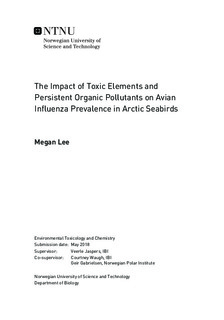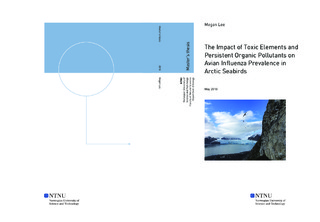| dc.description.abstract | As climate change alters northern environments, the dynamics of Arctic disease are predicted to undergo shifts. These shifts may also be influenced by the immunomodulatory properties of anthropogenic contaminants present in the Arctic. This study aimed to investigate the relationship between the prevalence of a climate-sensitive disease and concentrations of pollutants in an Arctic seabird.
We collected plasma samples from black-legged kittiwakes (Rissa tridactyla) breeding at Kongsfjorden, Svalbard. These samples were analyzed for toxic elements and screened for the avian influenza virus (AIV). Samples taken in previous years from the same kittiwake population, which had been already been analyzed for toxic elements and/or persistent organic pollutants (POPs), were also screened for the virus. Logistic regression models were developed to relate concentrations of contaminants to the probability of AIV infection in these birds. Samples from Svalbard glaucous gulls and Norwegian raptors were also screened for AIV.
Evidence of AIV infection was found in black-legged kittiwakes in 2014 and 2015, but not in 2017. The best-fit logistic regression model created with data from 2015 included arsenic, selenium, and mercury as significant explanatory variables. Arsenic and selenium increased the probability of infection while mercury decreased it. Further models created from combined 2014 and 2015 data did not show any significant influence of POPs over the probability of infection. AIV was also found in glaucous gulls, but not in raptors.
To our knowledge, this is the first evidence of AIV on Svalbard. The presence of the virus in multiple avian species emphasizes the need for broader screening efforts. Out of all studied contaminants, arsenic and selenium seem to pose the greatest risk for increasing AIV infection in kittiwakes. Mercury seems to decrease this risk, perhaps due to an antagonistic effect with selenium. This study did not find any influence of POPs over AIV infection, possibly because kittiwakes face relatively low levels of POP exposure.
Further research is needed to establish baseline knowledge about AIV on Svalbard and to clarify the relationships between pollutants and infection. This information is necessary to detect and predict shifts in AIV dynamics that may put wildlife at risk. | |

